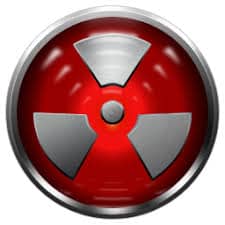Eraser is an advanced security tool for Windows which allows you to completely remove sensitive data from your hard drive by overwriting it several times with carefully selected patterns. This article will serve as an informative guide and give you a clear understanding of how to perform a silent installation of Eraser from the command line.
How to Install Eraser Silently
Eraser (32-bit) Silent Install (MSI)
- Download the latest Eraser (EXE) Installer
- Download the file to a folder created at (C:\Downloads)
- Extract the Eraser (x86).msi using 7-Zip
- Right-Click on the .EXE file and from the shortcut menu choose 7-Zip > Extract Here
- Open an Elevated Command Prompt by Right-Clicking on Command Prompt and select Run as Administrator
- Navigate to the C:\Downloads folder
- Enter the following command:
MsiExec.exe /i "Eraser (x86).msi" /qn
- Press Enter
After a few moments you should see the Eraser Desktop Shortcut appear. You will also find entries in the Start Menu, Installation Directory, and Programs and Features in the Control Panel.
| Software Title: | Eraser |
| Vendor: | The Eraser Project |
| Architecture: | x86 |
| Installer Type: | MSI |
| Silent Install Switch: | MsiExec.exe /i "Eraser (x86).msi" /qn |
| Silent Uninstall Switch: | MsiExec.exe /x "Eraser (x86).msi" /qn |
| Repair Command: | MsiExec.exe /fa "Eraser (x86).msi" /qn |
| Download Link: | https://eraser.heidi.ie/download/ |
| PowerShell Script: | https://silentinstallhq.com/eraser-install-and-uninstall-powershell/ |
Eraser (64-bit) Silent Install (MSI)
- Download the latest Eraser (EXE) Installer
- Download the file to a folder created at (C:\Downloads)
- Extract the Eraser (x64).msi using 7-Zip
- Right-Click on the .EXE file and from the shortcut menu choose 7-Zip > Extract Here
- Open an Elevated Command Prompt by Right-Clicking on Command Prompt and select Run as Administrator
- Navigate to the C:\Downloads folder
- Enter the following command:
MsiExec.exe /i "Eraser (x64).msi" /qn
- Press Enter
After a few moments you should see the Eraser Desktop Shortcut appear. You will also find entries in the Start Menu, Installation Directory, and Programs and Features in the Control Panel.
| Software Title: | Eraser |
| Vendor: | The Eraser Project |
| Architecture: | x64 |
| Installer Type: | MSI |
| Silent Install Switch: | MsiExec.exe /i "Eraser (x64).msi" /qn |
| Silent Uninstall Switch: | MsiExec.exe /x "Eraser (x64).msi" /qn |
| Repair Command: | MsiExec.exe /fa "Eraser (x64).msi" /qn |
| Download Link: | https://eraser.heidi.ie/download/ |
| PowerShell Script: | https://silentinstallhq.com/eraser-install-and-uninstall-powershell/ |
The information above provides a quick overview of the software title, vendor, silent install, and silent uninstall switches. The download links provided take you directly to the vendors website. Continue reading if you are interested in additional details and configurations.
Additional Configurations
Create an Installation Log File
The Eraser MSI installers offer the option to generate a log file during installation to assist with troubleshooting should any problems arise. You can use the following commands to create a verbose log file with details about the installation.
Eraser (32-bit) MSI Silent Install with Logging
MsiExec.exe /i "Eraser (x86).msi" /qn /L*V "%WINDIR%\Temp\Eraser-Install.log" |
Eraser (64-bit) MSI Silent Install with Logging
MsiExec.exe /i "Eraser (x64).msi" /qn /L*V "%WINDIR%\Temp\Eraser-Install.log" |
How to Uninstall Eraser Silently
Check out the Eraser Install and Uninstall (PowerShell) post for a scripted solution.
- Open an Elevated Command Prompt by Right-Clicking on Command Prompt and select Run as Administrator
- Enter one of the following commands:
| Version | Eraser Silent Uninstall String |
6.2.0.2991 (x86) |
MsiExec.exe /x {2D0F6407-DC40-40F9-97F2-A27D7AFE2635} /qn |
6.2.0.2991 (x64) |
MsiExec.exe /x {D13C63B1-1968-466D-A3C4-AE78BDDF35D2} /qn |
6.2.0.2990 (x86) |
MsiExec.exe /x {1E3B342D-9355-452B-B8A6-50DE4347B5C2} /qn |
6.2.0.2990 (x64) |
MsiExec.exe /x {D1A745EF-8B69-4575-A104-B192DD687AF3} /qn |
6.2.0.2989 (x86) |
MsiExec.exe /x {1624F011-11A1-4700-B886-D1137C3F95BD} /qn |
6.2.0.2989 (x64) |
MsiExec.exe /x {A8F9BDFF-27EA-478D-BC23-9F518B33E5E9} /qn |
6.2.0.2988 (x64) |
MsiExec.exe /x {081492D4-3465-4485-ABFA-CDD5B4A6E073} /qn |
6.2.0.2986 (x86) |
MsiExec.exe /x {44EB0559-A3B4-429B-8C62-97B37ECDDFFF} /qn |
6.2.0.2986 (x64) |
MsiExec.exe /x {5227C9E1-58FC-45DE-880C-0E4C3559837D} /qn |
6.2.0.2983 (x86) |
MsiExec.exe /x {946864D1-C2E7-4F28-8643-620F083B1640} /qn |
6.2.0.2983 (x64) |
MsiExec.exe /x {E753DB4D-70BA-49B6-B88B-42166C8E5160} /qn |
6.2.0.2982 (x86) |
MsiExec.exe /x {3D2EAB25-8304-4EA5-9A5A-2F7B530E2812} /qn |
6.2.0.2982 (x64) |
MsiExec.exe /x {DFCF78CC-3DAD-4C1E-8BC6-94DC5B73461E} /qn |
6.2.0.2979 (x86) |
MsiExec.exe /x {5D6BAB5F-157E-4570-BFAA-704651AC4ED2} /qn |
6.2.0.2979 (x64) |
MsiExec.exe /x {C5900DE9-D199-4C27-B692-354C9A6A6C8B} /qn |
6.2.0.2978 (x86) |
MsiExec.exe /x {72C7619F-A797-4B00-851D-7FEED17ADCDE} /qn |
6.2.0.2978 (x64) |
MsiExec.exe /x {3F294138-66B6-41E3-8BE7-4532E9C808ED} /qn |
6.2.0.2971 (x86) |
MsiExec.exe /x {F9EA3546-8EBB-49B3-84AC-40269767562C} /qn |
6.2.0.2971 (x64) |
MsiExec.exe /x {F0B4C9BD-D61B-4AE5-A345-F4BB5F452B5B} /qn |
6.2.0.2970 (x86) |
MsiExec.exe /x {C96D141B-91C0-4DC9-87B6-D8EB674CA0F8} /qn |
6.2.0.2970 (x64) |
MsiExec.exe /x {58F37E51-2A83-49F3-9117-6005C63CF399} /qn |
6.2.0.2969 (x86) |
MsiExec.exe /x {5140890B-8A88-4E81-A5C3-7B9F92F74FD2} /qn |
6.2.0.2969 (x64) |
MsiExec.exe /x {66AB13EA-E7D2-4CFC-9B66-8E9EE44C89EE} /qn |
6.2.0.2962 (x86) |
MsiExec.exe /x {03983F45-ED4B-4541-B00B-F31565F0756B} /qn |
6.2.0.2962 (x64) |
MsiExec.exe /x {C6E287F1-2E47-45F0-BB51-94F815CFFB48} /qn |
6.0.10.2620 (x86) |
MsiExec.exe /x {A45C5EC7-F13E-4414-99BE-47373935C0FE} /qn |
6.0.10.2620 (x64) |
MsiExec.exe /x {6E5159B4-A519-41EF-80EF-AD58371515DF} /qn |
6.0.9.2343 (x86) |
MsiExec.exe /x {18026153-83A4-40E0-96B6-41E441607518} /qn |
6.0.9.2343 (x64) |
MsiExec.exe /x {3D33F6F0-4D90-484D-A1D9-09AE791CCBD9} /qn |
6.0.8.2273 (x86) |
MsiExec.exe /x {392A74D0-4DFE-49F7-87C3-8A61708F8856} /qn |
6.0.8.2273 (x64) |
MsiExec.exe /x {A7EEF79E-06B2-4382-9D2E-39DBA0F72D50} /qn |
Always make sure to test everything in a development environment prior to implementing anything into production. The information in this article is provided “As Is” without warranty of any kind.

